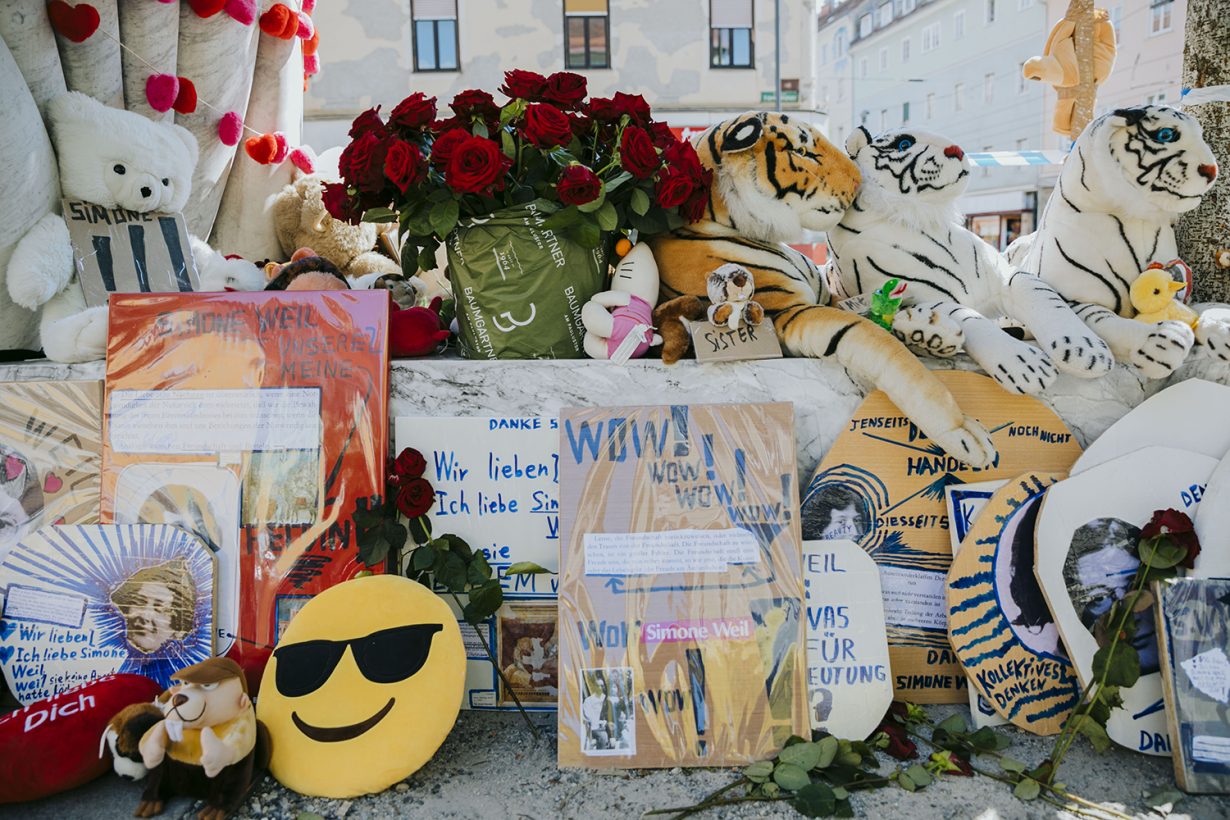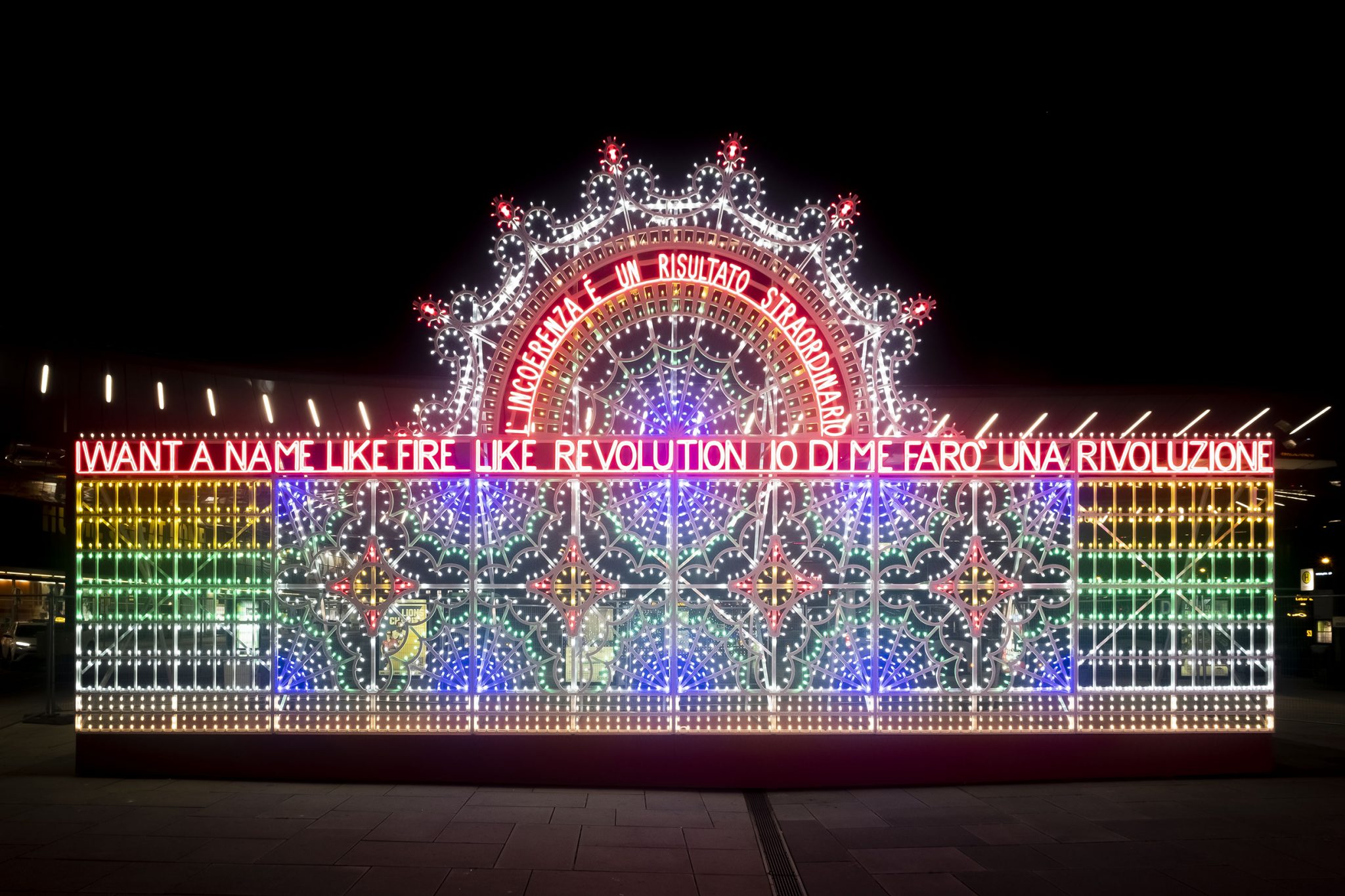After last year’s purely digital edition, the festival – based in Graz, Austria – ventures back into the analogue, and into the public space of the city
On the opening weekend of the 54th edition of Steirischer Herbst, as summer faded into autumn, Graz was in an increasingly hot phase of its mayoral election and at its most picturesque. After last year’s COVID-19-enforced, purely digital edition, Paranoia TV, the festival, under the vague rubric THE WAY OUT, ventured back into the analogue and, above all, into the public space of the city. Some works were strident enough to be unmissable: Marinella Senatore’s Assembly (2021), on Europlatz in front of the train station, was a poetic and, at night, dazzling entrance gate to the festival in the style of traditional luminarie art, composed of multicoloured lights and glowing texts (eg, ‘I want a name like fire / like revolution’). On the nearby Esperantoplatz, meanwhile, Thomas Hirschhorn’s parasitic extension of Jesper Neergaard’s 1987 permanent sculpture Espero into a Simone Weil Memorial (2021) served as another of his large, improvised, handcrafted homages to formative thinkers of the last century.

Expectations were ramped up by composer/drummer Uriel Barthélémi’s festival-opening Navigating the Ruins of the Old World (2021) and inaugural performances by Tino Sehgal and Flo Kasearu. In Kasearu’s Disorder Patrol (2021), security guards dressed in black accompanied a mounted group of uniformed colleagues in oversize headgear, continuously (and with only superficial politeness) asking the audience to clear the public space in the park that the horses and actors claimed for their performance: a smart exposure of spatial forces in the game between viewer and performer. Contrary to the security promised by the guards’ presence, the work served to instil fear, and to remind viewers of the very real counterparts to Kasearu’s fantasy troop who usually patrol parks like this.

Amid its food stalls and busy tram traffic, the main square provided the stage for the opening musical performance, a joint production by Barthélémi, singer and bassoonist Sophie Bernado, and dancer and choreographer Salomon Baneck-Asaro. The variety of topics listed in the programme – in the form of many urgent questions concerning colonialism, digitisation, monitoring and consumerism – seemingly couldn’t all be fitted into the performance. But the lively interplay between musicians and dancers – the movement, coordinated above all with Barthélémi’s drumming, between improvisation, break-dance and acting – was undeniable; and the audience, who’d been denied such performances due to restrictions, were clearly hungry for it. The sound of beer bottles falling over and trams arriving and departing onsite supported the piece acoustically, and to some extent reflected the interaction between art and public life intended by the festival.

The popular city parks Augarten and Stadtpark served, from sunrise to sunset, as the backdrop for Tino Sehgal’s characteristic constructed situations. Within his choreographed exercises – the chants and movements of the performers – the viewer was always addressed; if they gave consent, they were told a personal story, which in turn was an answer to a question formulated beforehand by the artist and given to the performers. Another inevitable question, however, was to what extent the context for fine, understated interventions like this has changed due to the emergence and consequences of the pandemic. More pronounced than the contrast his work provided to the usual bustle of the parks was the fact of a Sehgal performance even taking place nowadays, simulating a pre-COVID-19 normality. Less happily, in his first opera production, Conversations: I don’t know that word… yet (2021), Dejan Kaludjerovi´c proved how source material that was presumably originally interesting loses all tension when converted into an unsuitable performance format. The results of his research project Conversations, for which he has so far interviewed 49 children between the ages of six and ten, in seven countries, about integration, language, isolation, war, money, poverty, work, etc, and which have so far been presented in site-specific sound installations, now evaporated in a potpourri of monotonous sonic wallpaper spearheaded by four actors.

Originally developed during his studies, Hiwa K’s Cooking with Mama (2005 –) received a postpandemic update: now, a Graz-based cook with a migrant background cooks at the same time as her mother, in Turkey, cooks the same dish, the pair linked by video conference. Geographical and cultural distances are cooked away again. Elsewhere, the local artist group G.R.A.M. succeeded in creating a moment of surprise and sensual lightness, as 13 colourful so-called skydancers – usually hired for advertising purposes – danced to Graz-based musician Rainer Binder-Krieglstein’s song Radieschen on the roof of Kunsthaus Graz, a building also known as the ‘friendly alien’. The universal imagery of friendly aliens dancing on the friendly alien that flashed up in the brief performance made for some spontaneous fun at an edition of a festival whose programming, due to changeable restrictions, was surely not easy to put together, but whose orientation was much more diverse in the past.

There were notable exhibitions within the parallel programme – such as, at the HALLE FÜR KUNST Steiermark, the impressive insight into Kevin Jerome Everson’s diverse cinematic oeuvre, Recover, and, running concurrently, Doreen Garner’s brutal sculptural confrontation with the history of medical experiments on Black bodies in America, Steal, Kill and Destroy: A Thief Who Intended Them Maximum Harm – and outside, such as Oliver Ressler’s Barricading the Ice Sheets at Camera Austria, a research project based on the recent actions of the climate justice movement and one that intriguingly explores the boundaries between activism and art production. Elsewhere were urban interventions such as the poster series that dotted the city – with contributions by artists including Nilbar Güres¸, Hans Haacke, Boris Mikhailov, Dana Sherwood, Mounira Al Solh and Rosemarie Trockel – and a moving, telepathic confession of love in letter form to all inhabitants of Graz by the Spanish philosopher and queer theorist Paul B. Preciado, To all I will love (2021). But neither of these was able to distract from the fact that, as the festival got underway, THE WAY OUT appeared to excessively limit itself to one critical/didactic form of performance art, while at the same time looking both over-curated – aside from that of G.R.A.M., how every performance would go was described upfront – and, for a specialist audience, also a bit predictable.
Steirischer Herbst ’21, Various venues, Graz, 9 September – 10 October
